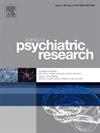电痉挛治疗后维持缓解的挑战——六个月随访研究的启示。
IF 3.7
2区 医学
Q1 PSYCHIATRY
引用次数: 0
摘要
电痉挛疗法(ECT)是一种被广泛认可的治疗严重抑郁症的方法,特别是在对药物干预反应不足或必须快速缓解症状的情况下。尽管电痉挛疗法疗效显著,但在成功的电痉挛治疗后,仍有相当比例的患者复发。方法:本研究调查了临床基线特征和与复发相关的残留抑郁症状-定义为蒙哥马利-Åsberg抑郁评定量表(MADRS)评分bbb15,重新开始ECT或自杀企图-成功电痉挛治疗后6个月内。数据来自PROTECT研究,这是一项在比利时Duffel大学精神病学中心进行的单点前瞻性队列研究。结果:在完成电痉挛治疗的65名患者中,40名患者(62%)获得缓解。在6个月时,对32例患者进行了重新评估,其中18例(56%)复发。复发与基线因素(包括年龄、社会环境、基线抑郁严重程度、精神运动症状、认知功能、治疗抵抗、锂离子使用或精神病或忧郁特征的存在)之间没有显著关联。电痉挛治疗结束时残留的抑郁症状也不能预测复发。讨论:观察到的高复发率强调了ECT后强有力的持续和维持策略的必要性。未来的研究应优先考虑更大的队列,以更好地确定复发的预测因素,并优化ect后的治疗方案。本文章由计算机程序翻译,如有差异,请以英文原文为准。
Challenges in maintaining remission after ECT – Insights from a six-month follow up study
Introduction
Electroconvulsive therapy (ECT) is a widely recognized treatment for severe depressive disorders, particularly in cases of inadequate response to pharmacological interventions or when rapid symptom relief is essential. Although ECT demonstrates high efficacy, a notable proportion of patients relapse after a successful ECT course.
Methods
This study investigated clinical baseline characteristics and residual depressive symptoms associated with relapse – defined as a Montgomery-Åsberg Depression Rating Scale (MADRS) score >15, restart of ECT, or suicide attempt - within six months after successful ECT. Data were obtained from the PROTECT study, a single-site, prospective cohort study conducted at the University Psychiatric Center Duffel, Belgium.
Results
– Among the 65 patients who completed the ECT course, 40 patients (62%) achieved remission. At six months, 32 patients were reassessed, and 18 (56%) of them experienced relapse. No significant associations were identified between relapse and baseline factors, including age, social circumstances, baseline depression severity, psychomotor symptoms, cognitive functioning, treatment resistance, lithium use, or the presence of psychotic or melancholic features. Residual depressive symptoms at the end of the ECT course also did not predict relapse.
Discussion
– The observed high relapse rate underscores the critical need for robust continuation and maintenance strategies following ECT. Future research should prioritize larger cohorts to better identify predictors of relapse and optimize post-ECT treatment protocols.
求助全文
通过发布文献求助,成功后即可免费获取论文全文。
去求助
来源期刊

Journal of psychiatric research
医学-精神病学
CiteScore
7.30
自引率
2.10%
发文量
622
审稿时长
130 days
期刊介绍:
Founded in 1961 to report on the latest work in psychiatry and cognate disciplines, the Journal of Psychiatric Research is dedicated to innovative and timely studies of four important areas of research:
(1) clinical studies of all disciplines relating to psychiatric illness, as well as normal human behaviour, including biochemical, physiological, genetic, environmental, social, psychological and epidemiological factors;
(2) basic studies pertaining to psychiatry in such fields as neuropsychopharmacology, neuroendocrinology, electrophysiology, genetics, experimental psychology and epidemiology;
(3) the growing application of clinical laboratory techniques in psychiatry, including imagery and spectroscopy of the brain, molecular biology and computer sciences;
 求助内容:
求助内容: 应助结果提醒方式:
应助结果提醒方式:


